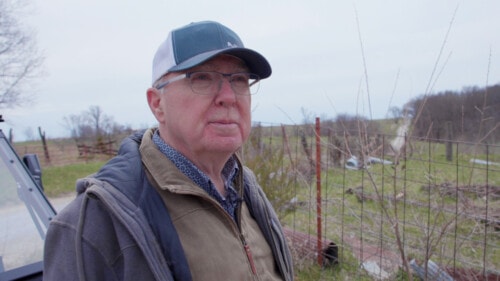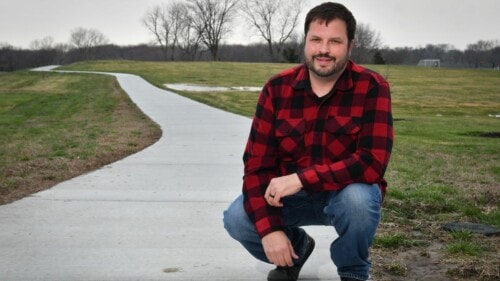Not Everyone in Kansas City Drives a Car. This Man has Been Riding the Bus for 45 Years Despite being designed for cars, Kansas City is home to people who rely on the bus every day. We spent a day riding along with Richard Heimer to learn what's working and what's not in our public transit system.
Published 2 hours ago
Above image credit: Richard Heimer takes his seat on the RideKC bus that takes him to work every morning. (Carlos Moreno | KCUR 89.3)Every weekday at 5:15 a.m., when it’s still dark out, Richard Heimer walks from his house on Drury Avenue to the bus stop at 24th and Hardesty, using a walking stick to navigate a buckled sidewalk covered in spiky gum tree balls.
He taps his way with confidence, but proceeds slowly, sometimes bumping into parked cars near the curb before self-correcting.
Heimer’s bus is the 12, and it departs at 5:30. He tries to arrive by 5:23, in case it shows up early. After a few minutes on the 12, Heimer transfers to the Prospect Max, which takes him to his destination: Alphapointe at 75th and Prospect.
If he misses one of his rides, Heimer will be late, at least according to him — his routine is calculated to allow time for drinking a cup of coffee and setting up his work station.
Although Heimer seems happy with his bus commute, it’s a time-consuming journey. What normally amounts to an 18-minute drive takes Heimer almost an hour. He arrives at 6:05 a.m.
A few weeks ago, I put out a public request for a bus commuter who might let me ride with them. A memorable note arrived in my inbox from Heimer’s coworker at Alphapointe, a nonprofit workplace outfitted with adaptations for people with blindness or low vision.
The coworker told me that most of the folks who work there “absolutely rely on public transportation.”
In other words: real experts in local transit.
Kansas City’s need for more robust, user-friendly transit has been a major talking point for years.
Most of us understand that our city’s near-total reliance on cars is bad for the environment, and doesn’t lead to the kind of vibrant urban setting many of us want to see here.
But the city was literally built for cars; we’ve decimated neighborhoods for highways, and prioritized parking lots in our development strategy.
Sidewalks can be non-existent, even along major thoroughfares. Where they do appear, they’re often uneven to the point of being hazardous, and too narrow for more than one pedestrian at a time. The neglect sends a clear message: the car commuter is the intended commuter.
Getting around Kansas City using anything other than a personal automobile requires a special kind of effort. Unlike the subway in New York City or the L in Chicago, Kansas City’s transit system isn’t one that locals universally learn to use as a rite of passage.
We have buses, and people definitely ride them, but plenty of Kansas Citians have never even set foot in one.
That leaves a serious gap in our shared understanding of what’s working in transit, and what’s really not.

Heimer’s been riding the bus in Kansas City — to work and back — for 45 years.
Now almost 70, Heimer’s been legally blind since he was 3.5 years old. He lost most of his vision in a farm accident in northeast Missouri, when the back of a hoe hit him in the eye.
He’s worked at Alphapointe since 1976. Right now, he makes specialized writing pens for U.S. military personnel. Some of the pens can break glass. Others write with special ink that can be read in the dark using night-vision goggles. Heimer’s machine can assemble up to 6,000 pens a day.
Heimer’s vision loss hasn’t stopped him from working, raising a family, and doing what he calls “normal stuff,” thanks to mobility training from a young age. One of the few things he can’t do, though, is drive a car. So transit access, for Heimer, is crucial.
When Heimer first moved into his house just east of Van Brunt, off 24th Street, he lived closer to work. Alphapointe — previously called The Kansas City Association for the Blind — was located downtown back then.
“I used to only have to take one bus,” Heimer tells me. “I had two choices though.” That made missing one less of a hassle, he explains.
Now, there isn’t much wiggle room — and that’s the case in both directions of his commute.

At Alphapointe, a bell rings to end the assembly shift at 3:30 p.m., and Heimer doesn’t waste any time leaving the building, conveniently located right beside the Prospect Max hub at 75th Street.
When the northbound bus stops and the doors open, the driver greets him by name. Then, seeing me trailing with a microphone, the driver adds: “I didn’t know you were a celebrity.”
Heimer is soft-spoken. As other riders get on and off the bus, some of them shout out greetings. People trade intel on route changes. One rider calls out to see if anyone has a pen she could borrow, then makes her way down the aisle when someone else holds one up in the air.
Heimer sits quietly, though, listening to the names of the stops so he can follow along. He’s waiting to feel the bus turn left; that’s how he’ll know it’s time to get up for his 12th Street transfer.
“It makes a left and then there’s a Church’s Chicken across from where we go,” Heimer tells me as we ride.

And sure enough, as the bus crests a hill and the driver turns left, the smell of fried chicken wafts by. Heimer prepares me for our exit before the announcement does.
We climb off of the bus with traffic whizzing by, and Heimer makes his way across the crosswalk at the busy 12th and Prospect intersection, tapping his cane to find a patch of dirt that functions as what he calls a “landmark.”
He stops at a shelter on the other side of the street, where he waits about 10 minutes for the eastbound 12.
The first bus that pulls up to the stop isn’t Heimer’s, and he knows it, so he doesn’t react to its arrival in the slightest. I feel the need to check just to be sure, but Heimer isn’t worried.
“The Max is here, and the 12th Street should be coming behind it,” he says, calm as can be.
“How did you know that one was the Max?” I ask.
“It just comes first. Most of the time. Not all the time,” he says, adding with a laugh: “I could be wrong.”
“No, you’re right, it’s the Max,” I reply. “Do you usually check?”
“Those people there sometimes tell me,” Heimer explains, pointing to some fellow passengers standing a few feet away. “Sometimes the 12 sneaks up on me.”

Some of Heimer’s coworkers use the Ride KC Freedom service — an app that lets transit users summon a rideshare service, rather than navigating the set routes crisscrossing the city. But Heimer prefers the bus by a longshot, because you never know how many stops the shared taxi will make for other passengers — or how far off your intended route it might take you.
With the bus, there are fewer surprises and detours. Sure, you have to navigate its route system. But the bus predictably goes where it’s supposed to go, when it’s supposed to go there.
Most of the time.
Last week, the 12 made a detour, which threw Heimer off. And sometimes, a scheduled bus just doesn’t show up, which creates some discomfort in extreme weather; if the 5:30 bus doesn’t show up at 24th and Hardesty, for example, Heimer has to wait until 6:17 for the next one.
“They say they don’t have enough drivers or something,” Heimer explains with a shrug.
One of my email respondents put it this way: “The bus is either super convenient or entirely impractical to use, there’s rarely a middle ground.”

Heimer mostly rides to work and back, with a few other regular routes. On weekends, he and his wife also take public transit to go shopping in Independence (she also has low vision; the two met in high school, hanging out in a recreation room with a jukebox). To visit the doctor, Heimer takes the Troost Max.
But when he raised his kids in Kansas City, Heimer took them everywhere they needed to go on the bus. His daughter, who attended Lincoln Prep, took the city bus to school instead of the school bus. She liked it better: it had air conditioning when it was hot, and heat when it was cold.
But after 45 years in Kansas City — with full mastery of the transit system he needs for his routines — Heimer says he still doesn’t feel like he knows the city very well. The Kansas City in which he lives is one carved out by bus routes.
Heimer’s final stop, on his after-work commute, isn’t the closest to his house — it just has a safer intersection to cross. He predicted an arrival at 4:50, and I check my watch when we get off the bus.
It’s 4:44. “Not bad,” I tell him.
Heimer laughs.
“Nope. Not bad,” he replies.
Gina Kaufmann is a columnist and podcaster with KCUR 89.3, a member of the KC Media Collective.






